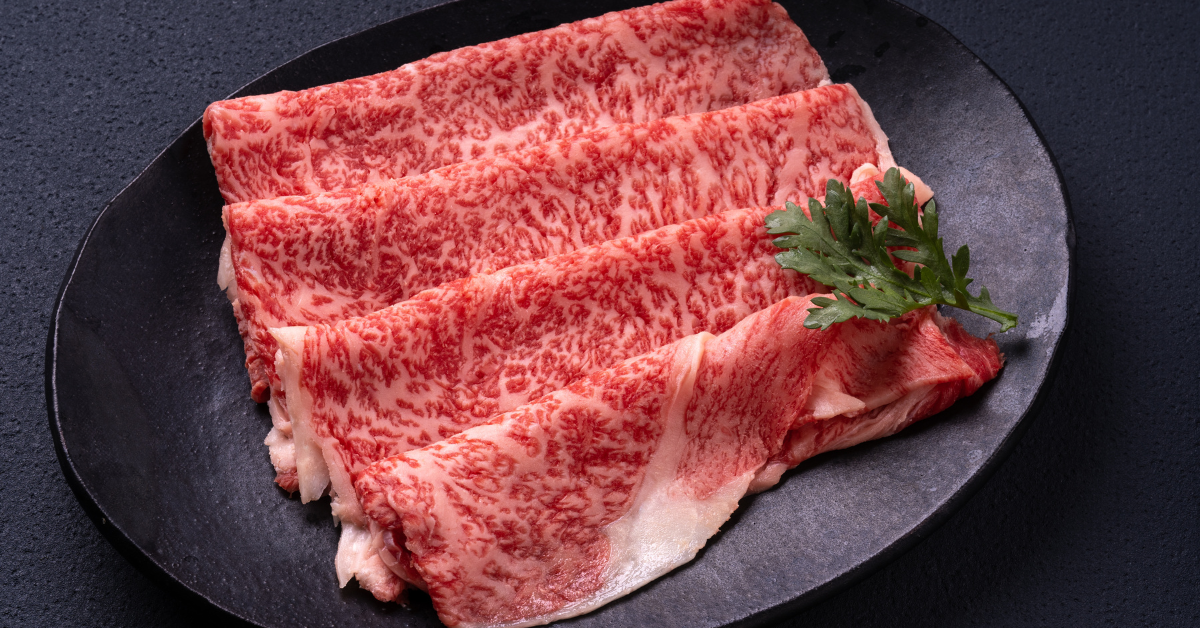Wagyu, often called Japan’s finest beef, is admired worldwide for its delicate marbling and unmatched flavor. More than just food, Wagyu represents tradition, craftsmanship, and cultural pride, making it an essential part of Japan’s identity.
Definition of Wagyu
Wagyu refers to breeds of cattle that originated in Japan and were later improved through selective breeding. There are four major types:
| Breed | Characteristics | Main Regions |
|---|---|---|
| Kuroge Washu (Japanese Black) | Fine marbling, extremely tender texture | Hyogo, Miyazaki, Kagoshima |
| Akage Washu (Japanese Brown) | Leaner, healthier, light taste | Kumamoto, Kochi |
| Nihon Tankaku (Japanese Shorthorn) | High protein, strong beef flavor | Tohoku region |
| Mukaku Washu (Japanese Polled) | Less fat, clean and light taste | Yamaguchi |
Among these, Kuroge Washu accounts for the vast majority of cattle raised in Japan.
History of Wagyu
Wagyu has long been intertwined with Japanese life.
- Ancient to Edo Period
Cattle were mainly used for farm labor and transportation, not for eating. - Meiji Era
With Western influence, beef consumption spread in Japan. - Modern Times
Through decades of selective breeding, marbled Wagyu beef was developed, with finely distributed fat and unique tenderness.
Wagyu is not just livestock; it is a cultural heritage shaped by Japanese tradition and agricultural techniques.
Wagyu’s Role in Japan
In Japan, Wagyu carries multiple values:
| Role | Description |
|---|---|
| Gift Item | Popular for celebrations and seasonal gifts such as New Year or summer presents |
| Tourism Resource | Tourists visit Japan specifically to try Kobe Beef, Matsusaka Beef, and other brands |
| Agricultural Symbol | Represents local farming traditions and advanced breeding skills |
Wagyu embodies Japanese lifestyle and regional pride.
Evaluation Standards for Wagyu
Wagyu is graded by a strict evaluation system.
| Category | Description | Grades |
|---|---|---|
| Yield Grade | Indicates how much meat can be obtained | A–C |
| Meat Quality Grade | Evaluates marbling, meat color, fat quality, texture | 1–5 |
For example, A5 Wagyu means the highest grade in both yield and quality, and it is sold at premium prices worldwide.
Diversity of Branded Wagyu
Many regions in Japan have their own unique Wagyu brands.
| Brand | Characteristics | Region |
|---|---|---|
| Kobe Beef | Exceptionally fine marbling, melts in the mouth | Hyogo |
| Matsusaka Beef | Sweet, rich fat flavor, only virgin female cattle | Mie |
| Omi Beef | One of the oldest Wagyu brands, balanced flavor | Shiga |
| Yonezawa Beef | Raised in the climate of Yamagata, rich umami taste | Yamagata |
Each brand must pass strict certification, making it a guarantee of quality and trust.
Wagyu’s Popularity Abroad
Wagyu is recognized worldwide as the finest beef.
- United States and Europe
High-end restaurants serve “Wagyu” steaks, considered luxury dining experiences. - Asia
In Hong Kong and Singapore, demand is strong among wealthy consumers, and Japanese Wagyu has become a cultural status symbol.
| Region | Characteristics | Consumption Trend |
|---|---|---|
| United States | Popular in luxury steakhouses | Customers order despite high prices |
| Europe | Fits into fine dining culture | Focus on small portions with high quality |
| Asia | Strong trust in Japanese brands | Linked directly to tourism demand |
Because exports are limited, Wagyu is extremely rare and therefore even more valuable.
Wagyu and Japanese Culture
Wagyu is not only food, but also a symbol of Japanese culture.
- Aesthetics of Food
It reflects Japan’s pursuit of beauty and delicacy in both appearance and texture. - Spirit of Hospitality
Served as a special dish to welcome guests. - Regional Pride
Local Wagyu brands act as symbols of their regions.
Through Wagyu, Japan’s values and traditions are shared with the world.
Cooking Styles and How to Enjoy Wagyu
The appeal of Wagyu also lies in its diverse cooking methods.
| Cooking Style | Characteristics | Appeal |
|---|---|---|
| Sukiyaki | Simmered in sweet soy-based broth | Fat sweetness blends with rich beef flavor |
| Shabu-shabu | Thin slices briefly dipped in hot water | Highlights tenderness and lightness |
| Yakiniku (Grilled Meat) | Seared quickly over high heat | Juiciness and aroma of fat stand out |
These styles emphasize the versatility and depth of Wagyu cuisine.
Conclusion
Wagyu is a treasure of Japan’s food culture, nurtured through history, tradition, and craftsmanship. Its value as a luxury food is undeniable, but it is also deeply connected to Japanese lifestyle, hospitality, and regional identity.
For visitors, Wagyu offers a unique experience that can only be had in Japan, making it one of the highlights of any trip.






